3D Mycotoxin Risk Management for Livestock & Poultry
- Feed Safety
By Dr. J. Pothanna, Technical Manager, Niwas Balaji, Laboratory Manager, Trouw Nutrition South Asia
Mycotoxicosis is a term used to describe a variety of illnesses that are caused by exposure to mycotoxins, which are toxic substances produced by certain types of fungi. Poultry is particularly susceptible to mycotoxicosis, as they are often fed diets that contain a variety of grains and other ingredients that may be contaminated with mycotoxins.
Multiple mycotoxicosis in poultry refers to the presence of two or more different mycotoxins in the same feed or feed ingredient, which can lead to more severe and complex symptoms. The symptoms of mycotoxicosis in poultry can vary depending on the type and severity of the toxin exposure.
Some of the most common symptoms include decreased feed intake, reduced growth, poor egg production, decreased immunity, and even death in severe cases. When multiple mycotoxins are present, the symptoms may be more severe and may include a range of different effects on the birds' health and performance.
Preventing multiple mycotoxicosis in poultry and livestock requires careful management of feed and feed ingredients. This may include regularly testing feed for mycotoxin contamination, storing feed in appropriate conditions to prevent fungal growth, and avoiding the use of ingredients that are known to be high-risk for mycotoxins. In cases where mycotoxicosis is suspected, it is important to work with a veterinarian to diagnose the problem and develop a treatment plan that is appropriate for the specific types of mycotoxins present.
The most important mycotoxins that are called Big 6 are -Aflatoxin, Ochratoxin, T2 toxin, Fumonisins, DON and Zearalenone.
Emerging mycotoxins are a group of newly discovered or less commonly known toxins produced by fungi that can contaminate crops, food, and feed. Research on emerging mycotoxins is important because they can pose potential risks to human and animal health and their occurrence and levels are not currently regulated or monitored in many countries. Some examples of emerging mycotoxins are Sterigmatocystin; Enniatin B; Roquefortine C.
3 D Approach to Mitigate Mycotoxin Risk: TOXO-XL is part of the mycotoxin risk management programme that helps identify, reduce, and monitor the risk of mycotoxins in raw materials and complete feed.

TOXO® XL is based on 3 pillars of protection:
1.Mycotoxin binding
2.Gut wall protection
3.Immuno modulation
1)Mycotoxin Binding: The high quality smectites binds with the polar mycotoxins and reduces their bioavailability in the animal body (Big 6 - Aflatoxin, Ochratoxin, T2 toxin, Fumonisins, DON and Zearalenone). Recent studies on emerging mycotoxin binding -like Sterigmatocystin; Enniatin B; Roquefortine C shows excellent binding at pH 3 and 6.
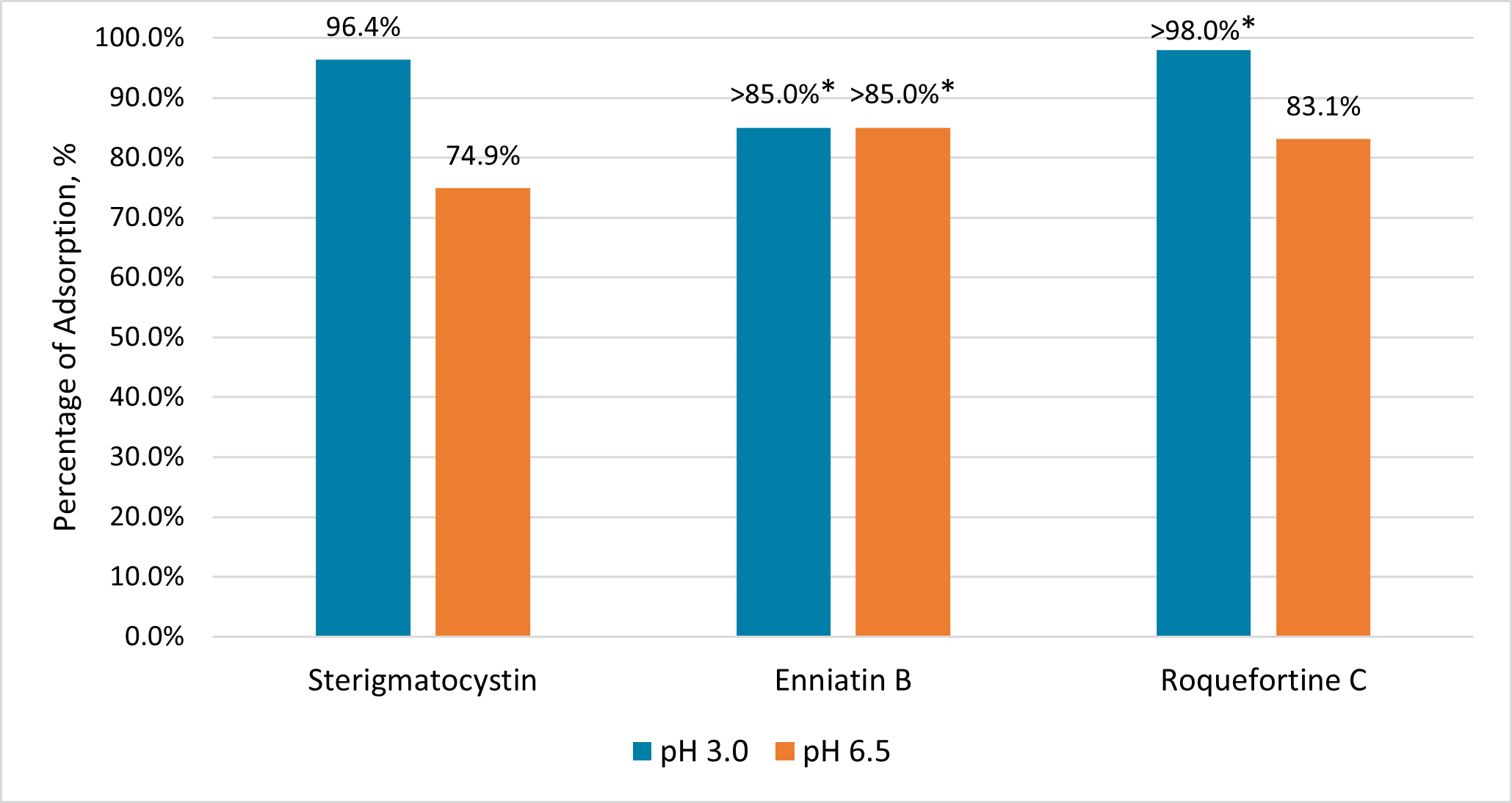
Aokin (Germany)-0.2% sample at pH 3.0 and 6.5(1000 ppb Sterigmatocystin;1000 ppb Enniatin B;1000 ppb Roquefortine C)
Endotoxin (LPS Binding): Lipopolysaccharides (LPS) are large molecules consisting of a lipid and a polysaccharide that are bacterial toxins. They are composed of an O-antigen, an outer core, and an inner core all joined by covalent bonds, and are found in the outer membrane of Gram-negative bacteria. Today, the term endotoxin is often used synonymously with LPS.
- LPS symptoms include reduced feed intake, increased intestinal permeability, hepatic necrosis, and increased morbidity.
- LPS reduces mycotoxin (e.g. DON) elimination rate and therefore lengthens mycotoxins exposure to animals.
Toxo range of products can effectively bind with LPS at pH 3 and 7 ensuring better intestinal health.
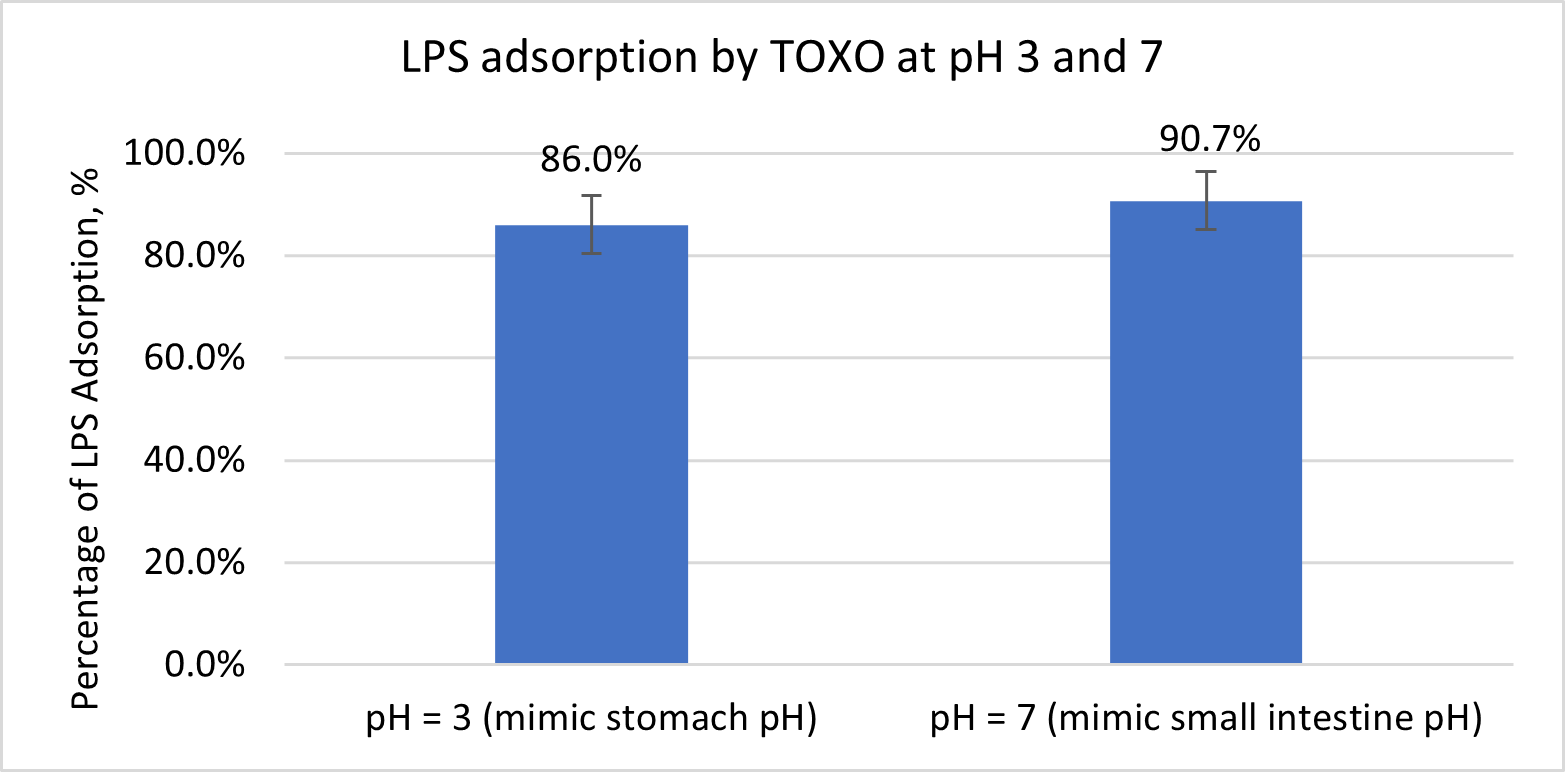
Source: TN Internal data
2)Gut wall protection: Toxo-XL ensures better gut wall protection due to glucose biopolymers present as active component. It actively reinforces gut integrity

Source: Nutreco R&D (ISO 9001:2015 certification)-Effects of Toxo XL in Villi /Crypt Depth @ day 42
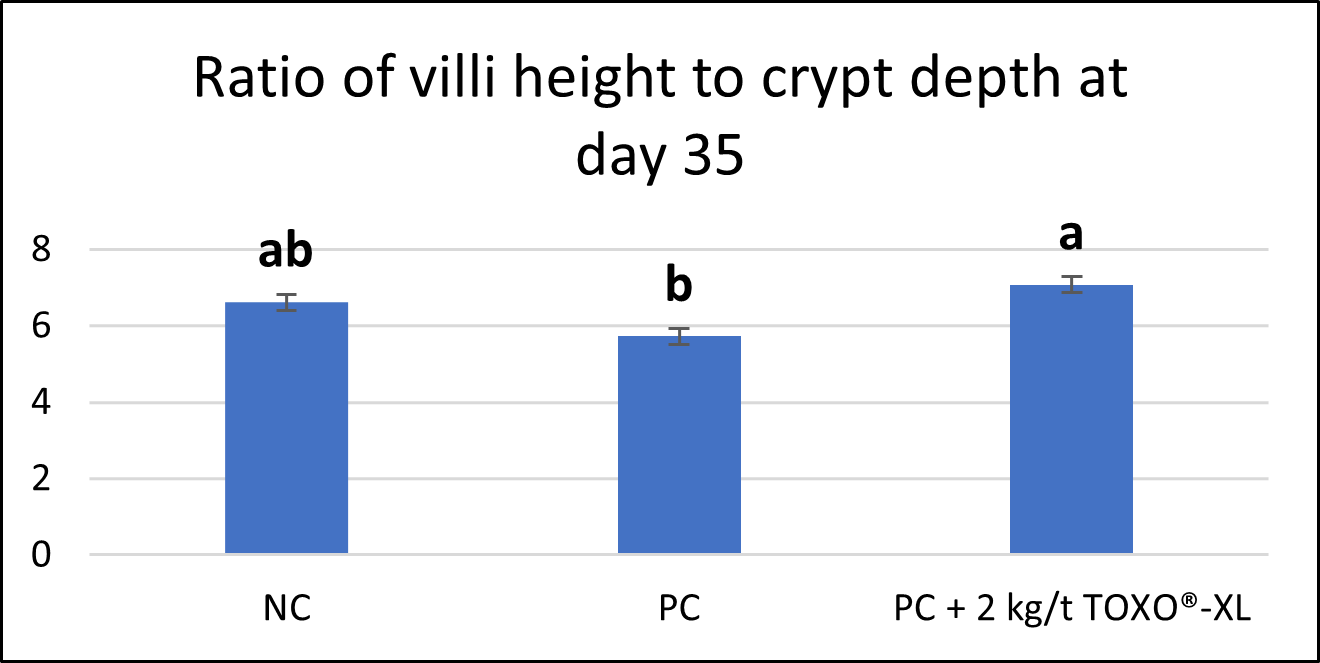
|
Trial info |
|
|
Facility |
Nutreco R&D (ISO 9001:2015 certification) |
|
Species |
Broiler |
|
# animals |
1980 in total |
|
Duration |
35 days |
|
Mycotoxins source |
Naturally contaminated feed |
|
Analysis |
By University of Guelph (Canada) |
Source: Nutreco R&D (ISO 9001:2015 certification)-Effects of Toxo XL in Villi /Crypt Depth @ day 42
|
Diet |
Description |
Mycotoxins (ppb) |
TOXO-XL |
|
1 |
NC |
0 |
0 |
|
2 |
PC |
≈ 6 ppm DON |
0 |
|
3 |
PC + Solution |
≈ 6 ppm DON |
2 kg/t |
Toxo XL Support for gut integrity through specific glucose biopolymers, reinforcing enterocyte tight junction protein complexes, which are damaged by inflammation during mycotoxin exposure.
3)Immunomodulation: ß-glucans in the second yeast cell wall modulate immunity through macrophage activation
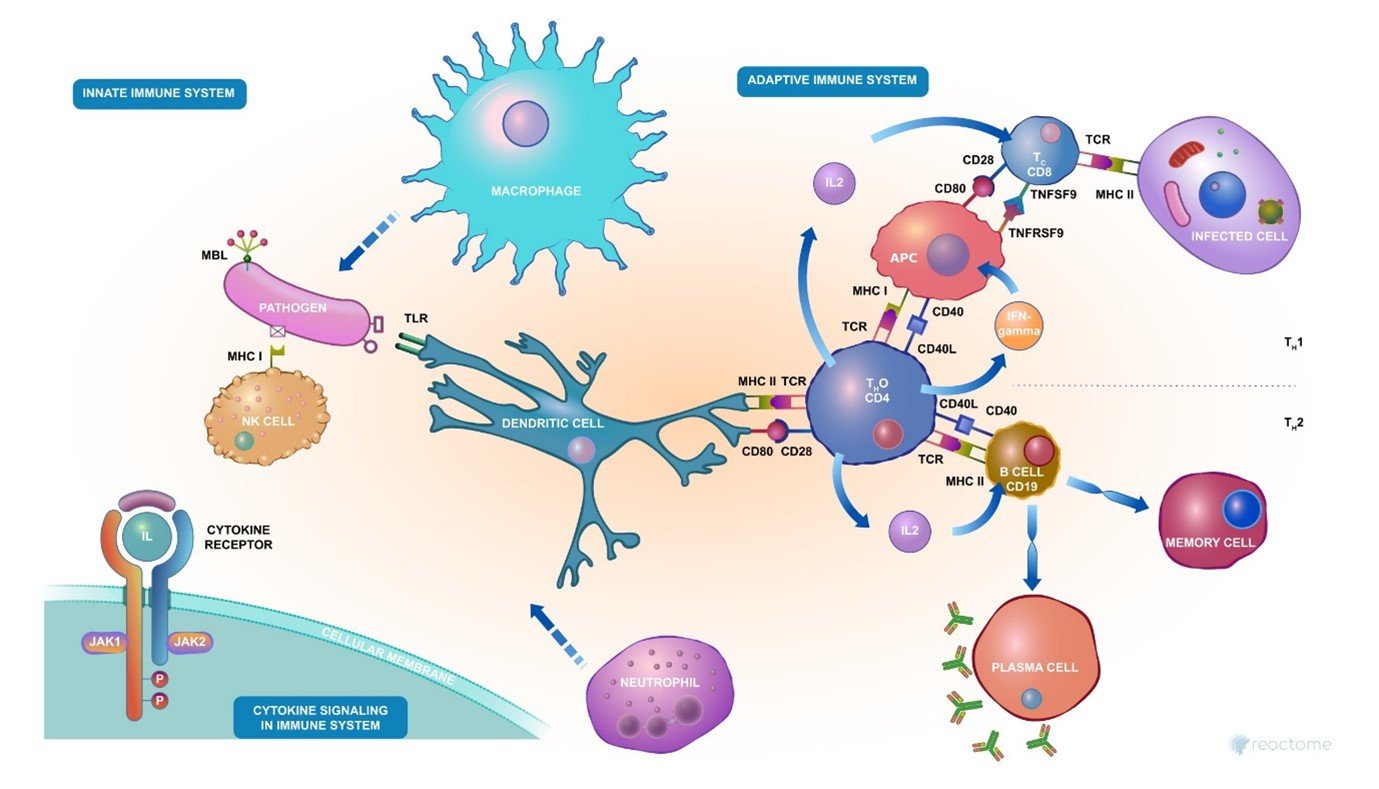
Effect on Antibody Titre Against NCD & IBD: Toxo XL can elicit better immune response in challenged groups. When in Positive Control( PC) the ND and IBD titres are decreased , inclusion of Toxo XL in PC was able to mitigate the negative effects of mycotoxins.
|
Treatment |
NDV titres, log10 |
IBDV titres, log10 |
||
|
day 21 |
day 42 |
day 21 |
day 42 |
|
|
NC |
1.36 a |
1.07 a |
1103 a |
1625 a |
|
PC |
0.96 b |
0.51 b |
700 b |
981 b |
|
TOXO-XL1 |
1.13 ab |
0.99 a |
774 b |
1426 a |
|
TOXO-XL2 |
1.25 ab |
1.04 a |
1155 a |
1540 a |
|
SEM |
0.04 |
0.04 |
43.6 |
57.4 |
|
p-value |
0.006 |
<0.0001 |
<0.0001 |
0.0001 |
a–b values in a column with no common superscripts differ significantly (p ≤ 0.05). Mean values are based on 3 birds (d21) and 2 birds (d42) per pen and 10 replicates per treatment. (Source: TN Internal study)
Effects of Multiple Mycotoxins in Breeders: Mycotoxins can negatively impact a diversity of indices that are necessary for the success of breeder and hatchery production: fertility, eggshell quality, efficiency of vaccine response and quality of the progeny.
Toxo-XL has shown to counteract the negative effects of multiple mycotoxin challenge in breeders. Breeders are long living birds with constant production stress. Even low levels of mycotoxins in their diets can make them susceptible to chronic mycotoxicosis which can hamper production and health.
Effects of Toxo XL In organ health in Breeders:
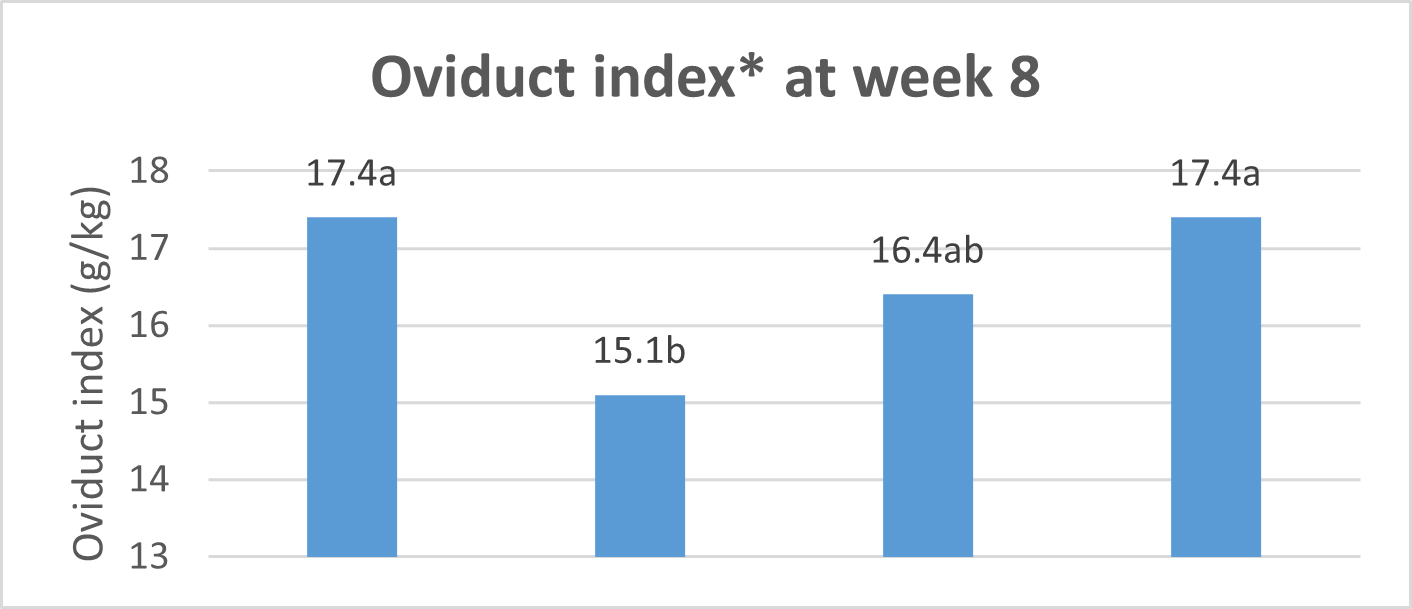
Mycotoxins (PC) significantly induced the atrophy of oviduct at week 8 (vs. NC). Both 1.0 and 2.0 kg/t TOXO-XL mitigated this atrophy, which may help to maintain the laying performance.
Effects of Toxo-XL in laying performance:
|
NC |
PC |
TOXO-XL-1 |
TOXO-XL-2 |
||
|
Mean value after 8 weeks |
Egg laying rate* (%) |
84.61a |
78.20b |
83.00ab |
85.09a |
|
Total egg weight* (kg/hen) |
3.07a |
2.85b |
2.99ab |
3.05a |
|
|
Feed/egg ratio* (kg/kg) |
2.96ab |
3.22a |
3.05ab |
2.97b |
|
- Mycotoxins (PC) significantly impaired egg-laying rate and FCR (vs. NC)
- TOXO-XL-1 increased egg-laying rate by +4.80% and reduced FCR by -0.17 (vs. PC)
- TOXO-XL-2 increased egg-laying rate by +6.89% and reduced FCR by -0.25 (vs. PC)
Hatchability:
|
NC |
PC |
TOXO-XL-1 |
TOXO-XL-2 |
||
|
At week 4 |
Settable eggs (%) |
86.3 |
84.2 |
83.9 |
86.0 |
|
Fertility of settable eggs(%) |
94.6 |
91.2 |
94.0 |
94.3 |
|
|
Hatch of fertilized eggs(%) |
88.5 |
84.9 |
86.2 |
89.8 |
|
|
Hatch of total produced eggs (%) |
72.9 |
66.8 |
68.6 |
73.1 |
|
|
At week 8 |
Settable eggs* (%) |
87.5a |
82.6b |
83.7ab |
85.8ab |
|
Fertility of settable eggs(%) |
95.6 |
93.8 |
94.5 |
94.6 |
|
|
Hatch of fertilized eggs(%) |
89.1 |
86.6 |
87.9 |
90.3 |
|
|
Hatch of total produced eggs* (%) |
75.5a |
67.1b |
69.7ab |
73.4ab |
|
- Mycotoxins (PC) significantly reduced the egg hatchability at week 8 (vs. NC)
- TOXO-XL 1 improved the egg hatchability by 2.6% (vs. PC) TOXO-XL 2 improved the egg hatchability by 6.3% (vs. PC)
Broiler Breeders are sensitive to multiple mycotoxins and are prone to chronic mycotoxicosis. The extensive in vivo studies document the positive effects of TOXO-XL on health and performance of broiler breeder hens exposed to multiple mycotoxins. Inclusion of Toxo-XL in Mycotoxin Risk management program can ensure organ health, improve performance by improving laying % and hatchability % which are negatively impacted by multiple mycotoxin challenges.
It is impossible to have one silver bullet to bind and eliminate all mycotoxins, emerging mycotoxins and counteract the immunosuppression caused by synergies and interactions of multiple mycotoxins. Hence, producers need to look at more integrated and holistic approach to counter multiple mycotoxin challenge.
3-D approach gives a more rational, scientific approach to negate the detrimental effects of multiple mycotoxin challenges in poultry and livestock production.
For further information, kindly write to us at customercareindia@trouwnutrition.com or visit our website: www.trouwnutrition.in